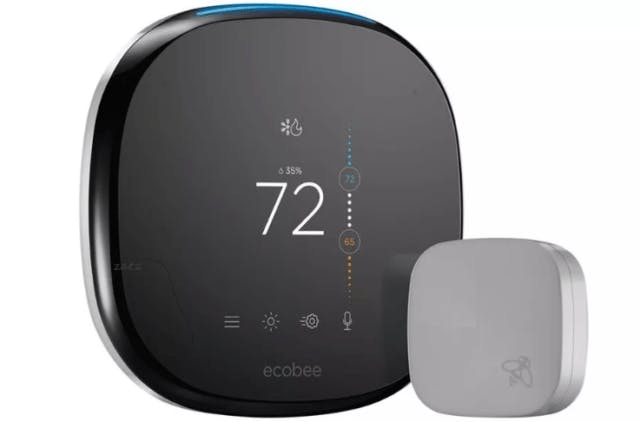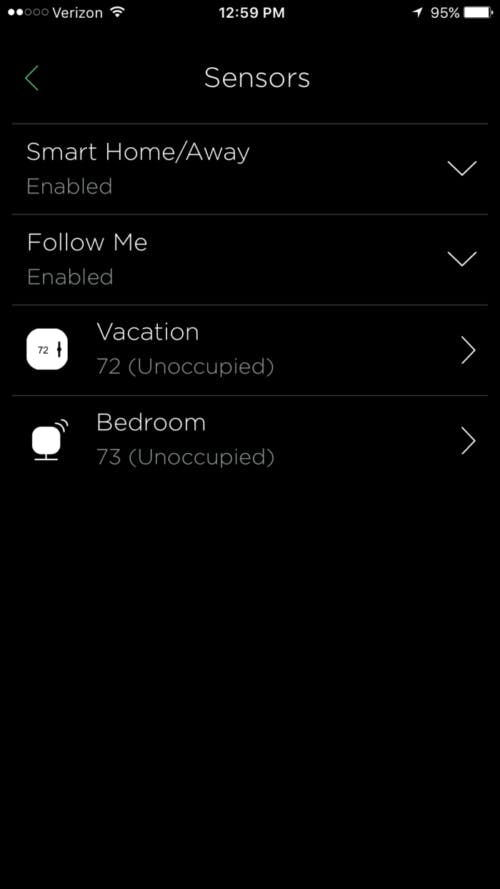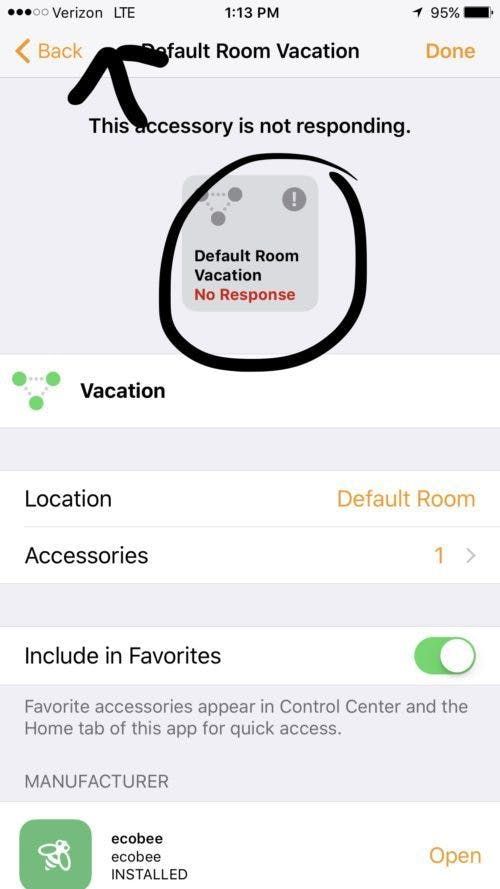
When ecobee4 launched a couple of years ago, it was overkill. Compared to other smart thermostats, it has more features and it has the strongest integration with Amazon Alexa. It also improves upon ecobee3's already smart features.
ecobee4 For Energy Savings and Comfort
One of the top reasons why people buy a $200+ thermostat is to save energy. What’s nice about ecobee4 is that it has retained the same feature set as ecobee3, features that are time-tested and add value, including energy savings.
Schedules
ecobee4 supports schedules, just like a good ole’ programmable thermostat can. You can tell the thermostat how cold/warm you want your house to be and at what time. By doing so, you’re preventing your HVAC system from unnecessarily consuming power while you’re away. But if this feature is present in programmable thermostats, why spend $250 on ecobee4? The answer is: it has a lot more to offer
Modes
Aside from schedules, ecobee supports Modes to help you set your thermostat. Modes are like shortcuts. With one touch, you can make ecobee4 go to a predetermined setting.
There are four basic Modes: Home, Away, Sleep, and Vacation. You can customize each mode by asking yourself, “How do I want my HVAC system to behave when I’m home, away, asleep, or on vacation?” Once answered, you can then program each mode accordingly. After setting the Modes, you can activate them by touching the appropriate icon on ecobee4’s touchscreen interface. You can also integrate the Modes into your schedule, so that while creating schedules, instead of customizing the temperature for each time period, you can simply tell ecobee when you’re home, away, asleep, or on vacation.
App Control
Another nifty feature is app control, the ability to control ecobee4 via your smartphone using the ecobee app. The changes you make via the ecobee app get sent to the cloud and then to ecobee4 via the internet. Our tester went hands-on with ecobee3 and made this nifty chart showing what you can do with the app versus controlling the device using its screen or even the web portal.
| App | Touchscreen | Web Portal | |
|---|---|---|---|
| Smart Home/Away | |||
| Follow Me | |||
| Comfort Settings | |||
| Weekly Schedule | |||
| Vacation | |||
| Reboot | |||
| Reminders & Alerts | |||
| Customizing Your Thermostat | |||
| Hold Action Duration | |||
| Smart Recovery | |||
| Access Control | |||
| Configure Wi-Fi and Advanced Settings | |||
| Diagnostics | |||
| Configure HomeKit | |||
| Offline Notifications |
As you can see, the app enables you to set the temperature manually, create schedules, and more.
ecobee has apps for both Android and iOS devices plus a web app for browser-enabled devices. Both the Android app (3.8 stars out of 5) and the iOS app (3 stars out of 5) are well-received by users.
For the sake of showing how important app control is, let’s run through a scenario. Let’s say you’ve already scheduled your thermostat to fire up before you get home from work. But then, your boss asks you to stay late. With a programmable thermostat, you have no choice but to let your heater run until you arrive. Such a waste of energy.
Geofencing
What if you have to leave or arrive home earlier than scheduled? Worry not, because ecobee4 supports geofencing. This feature tracks your phone’s location. First, you create a virtual perimeter around your home. When you (or rather, your phone) enter the area, ecobee4 automatically swaps to Home mode. When you’re outside the geofenced area, ecobee4 swaps to Away mode. Geofencing can work side-by-side with schedules and Modes. If your thermostat is set to Away mode, but you suddenly arrive home, geofencing will override your schedule and set the thermostat to Home.
Smart Sensors

Schedules, Modes, app control, and geofencing are all useful features, but they’re not as unique as you probably think they are. Nest has these features, as does Honeywell Lyric Round. What puts ecobee4 ahead of the competition is its compatibility with Room Sensors.
Room Sensors are puck-sized sensors designed to monitor multiple key rooms of your house such as bedrooms, living rooms, and kitchens. The sensors include a motion sensor that tells them if a room is occupied or not. The motion sensor allows the Room Sensor to perform several valuable functions.
First, the Room Sensors detect occupancy. If a room is occupied, room sensors can override schedules. If it sees that a room is occupied during an Away period, it tells the thermostat to set to Home mode. On the other hand, if there’s no activity during a Home period, it tells the thermostat that you’re away.
Second, Room Sensors provide comfort by helping ecobee4 optimize the temperature in occupied rooms. Most smart thermostats only measure the temperature in the room they reside. Room Sensors use their built-in temperature sensors to tell ecobee4 which rooms are occupied and the occupied room’s temperature. If you’re in your bedroom and all other rooms are empty, the thermostat adjusts your room’s temperature to your desired temperature, even if this means making all the other rooms a little colder or warmer. In ecobee’s terms, this feature is called Follow Me. It ensures that the temperature in an occupied room is always optimal.
Third, if you want to take total control, you can use a feature called sensor participation. This feature is similar to Follow Me, but instead of automatically choosing which Room Sensor to prioritize, ecobee4 relies on the Room Sensors you choose. You can tell ecobee which smart sensor to take readings from so that in the morning when everyone is having breakfast, you can tell the thermostat to prioritize the Room Sensor in your dining room.
ecobee4 can pair with up to 32 smart sensors, but you don’t need that many sensors. In average homes, 3 to 5 sensors will usually get the job done. If you’re a current ecobee3 user, your ecobee3 smart sensors will also work with ecobee4.
NOTE: Nest recently launched Temperature Sensors. Unlike ecobee’s Room Sensors, Temperature Sensors only measure the temperature and report back the reading to Nest (Nest E or 3rd Generation Nest Learning only). Nest then uses the information to obtain the desired temperature in your rooms. Nest’s Temperature Sensors lack motion detectors so they can’t detect room occupancy.
Thermal Profiling
Another feature that makes ecobee4 great is its ability to profile your home based on multiple data points. It uses its understanding of your home’s thermal profile to know when to start preheating or cooling to reach your desired temperature at the right time while minimizing power consumption.
During setup, you can help ecobee4 understand your home’s thermal profile by providing its size, age, and type as well as the number of people living in it. ecobee also learns over time, allowing it to understand how weather patterns and the performance of your heating equipment affect the temperature in your home.
Extra Features
Finally, there are extra features that, when used properly, can help you further decrease power consumption and increase your home’s comfort level.
- Reminders and Alerts– A well-maintained HVAC system is an energy-efficient one. ecobee can remind you to have your HVAC system serviced every year and filters replaced regularly.
- Setbacks/Setforwards– Your home doesn’t have to be 72 degrees all the time. Setbacks tell ecobee4 to call for heat only when the temperature drops a few degrees lower than your desired temperature. Setforwards tell ecobee4 to call for cool only when the temperature rises a few degrees higher than your desired temperature.
- Fan’s Minimum Run Time– Fans help distribute cool/warm air evenly around the house, which means less HVAC run time and less energy consumption if you set a minimum run time.
- Access Control– Parents, teach your kids to use thermostats efficiently. But if you can’t teach them, enable Access Control, so only you and those who know the password can set the thermostat.
ecobee4 Talks To Smart Home Platforms
ecobee4 goes beyond saving energy and providing comfort. If you’re a smart home user, you can make ecobee4 a part of your smart home system.
IFTTT
One of our favorite ecobee integrations is IFTTT. IFTTT is a service that allows you to create IF/THEN rules that involve a variety of products and services. It works with Philips Hue, WeMo, Camio, Piper, August, Amazon Alexa, Ring, and over 400 other smart home services, apps, and brands.
With IFTTT, you can set rules (called Applets) triggered by ecobee4’s temperature. For example, when the temperature is higher/lower than ____, then do ____. Or you can create rules around humidity. For example, if humidity is higher/lower than ____, then ____. These events can trigger anything from your lights to your smart humidifier and cause them to take action.
ecobee4 can also be on the other side of the Applet, the one taking action. Different triggers can set the thermostat to a temperature hold, setting your home to your desired temperature for hours or even until the next time you change it. Triggers can also make ecobee4 swap modes. For example, “If you exit an area (Location Applet), then set an indefinite hold (ecobee Applet).”
SmartThings
ecobee4 also works with SmartThings, one of the most robust smart home systems today. By pairing ecobee4 with your SmartThings system, you can control your thermostat via the SmartThings app and integrate it into scenes. You can even use SmartThings’ geofencing feature to control ecobee4 based on your location.
HomeKit
ecobee4 and the other ecobee smart thermostats are also HomeKit compatible. You can control the thermostats using your iPhone’s Home App (for iOS 10 or later) or even Siri. You can also make ecobee4 a part of your HomeKit scenes or make it respond to your location (geofencing). The catch? If you want to control ecobee4 via HomeKit from outside your home network, you’ll need an Apple TV (3rd generation or later) or an iPad functioning as a home hub.

ecobee4’s built-in occupancy and temperature sensor and add-on Room Sensors also have roles in the HomeKit ecosystem. You can use ecobee4’s occupancy sensor and temperature sensor to create automation scenes. You can use ecobee4’s ability to detect your presence to trigger other HomeKit devices. The remote sensors, on the other hand, help HomeKit pinpoint which rooms are occupied to activate relevant automation scenes when needed. They also serve as temperature readers for HomeKit.
abode
ecobee also works directly with the abode home security system. The integration allows you to create quick actions and automations that combine your ecobee thermostat with your abode security system. For example, if your abode system is armed away, it can tell your thermostat that you are away. It can also use other data points such as your smartphone location and your set schedule.
Google Assistant
ecobee4 works with three voice assistants including Google Assistant. Using your voice, you can control your thermostat with your voice using your Google Home device.
ecobee4 + Alexa
And last, but not least, ecobee4 is a virtual assistant device thanks to ecobee’s partnership with Amazon’s Alexa. Previous ecobee thermostats, ecobee3 and ecobee3 Lite, were both compatible with Alexa devices (Echo, Echo Dot, Spot, Show, Plus, etc.). However, with ecobee4, you no longer need an Alexa device as ecobee4 IS an Alexa device.
The ecobee Smart Home Skill lets you control the temperature with your voice and ask Alexa what the temperature is in a certain room. ecobee Plus is a newer Alexa Skill that also enables voice control features such as fan control, resuming schedules, and comfort settings.
ecobee4 is equipped with speakers and far-field microphones that enable it to hear your voice commands from across a room. Anything you want to ask Alexa you can ask your ecobee4. You can even play music from Amazon Music, TuneIn, and iHeartRadio, although ecobee4’s speaker isn’t going to help you raise the roof. NOTE: Currently, ecobee4 doesn’t support Spotify or Pandora services.
Placing Alexa Voice Services into ecobee4 isn’t ecobee’s end game. They have a more grandiose plan: Putting an Alexa-enabled device in every room of your home for whole-home voice control. This plan involves another product that was announced alongside ecobee4 and is now available for purchase: the ecobee Switch+. What’s most intriguing about this smart switch is that it also has Alexa built-in. Like ecobee4, you can speak to Alexa through the device. Switch+ also functions as an occupancy and temperature sensor, even possibly replacing your smart sensors in other rooms.
If you’re wondering if putting a listening device in every room will hamper your privacy, you’re not alone. Alexa devices are always on and always listening. Of course, recordings are only sent to the cloud when the wake word “Alexa” is spoken, but most Alexa owners will tell you that sometimes the device wakes when you say things that don’t sound like Alexa at all. Our advice? Don’t place the device in areas where people have a reasonable expectation of privacy.
ecobee4 vs ecobee3 vs ecobee3 Lite
| ecobee4 | ecobee3 | ecobee3 Lite | |
|---|---|---|---|
| Dimensions (inches) | 4.29 x 4.29 x 1.02 | 3.93 x 3.93 x 0.87 | 4.05 x 4.05 x 0.84 |
| Display | 3.5″ Full-Color Display (Touch Enabled) | 3.5″ Full-Color Display (Touch Enabled) | 3.5″ Full-Color Display (Touch Enabled) |
| Humidifier/Dehumidifier /Ventilator Compatible | |||
| Wi-Fi Compatibility | 2.4GHz b/g/n | 2.4GHz b/g/n | 2.4GHz b/g/n |
| Occupancy Detection | Built-in | Built-in | via Smart Sensors |
| Smart Sensor Compatibility | Gen 2 Smart Sensors (1 included in package) | Gen 2 Smart Sensors (1 included in package) | Gen 1 Smart Sensors (Sold Separately |
| HomeKit Integration | |||
| IFTTT Support | |||
| SmartThings Support | |||
| Works With Amazon Alexa | |||
| Works With Google Assistant | |||
| Built-In Alexa Voice Service | |||
| Where to Buy | Buy Here | Buy Here | Buy Here |
ecobee4 is the same as ecobee3 in terms of thermostat features. The only difference between the two is Alexa Voice Service. If you currently own an ecobee3, We don’t recommend that you spend $250 on ecobee4. If you’re interested in Alexa, we suggest purchasing the $39.99 Echo Dot.
If you’re an ecobee3 Lite user, we also don’t recommend upgrading to ecobee4. ecobee4 will only add a couple of new features (humidifier, dehumidifier, and ventilator control) and a built-in occupancy sensor.
So, to whom do we recommend ecobee4? We recommend it to homeowners who are new to smart thermostats. ecobee4 is a good way to jumpstart your smart home because it introduces two technologies in one device: a smart thermostat and voice control. You can buy ecobee4 for $189.79.

